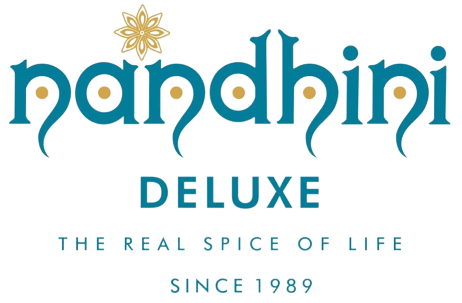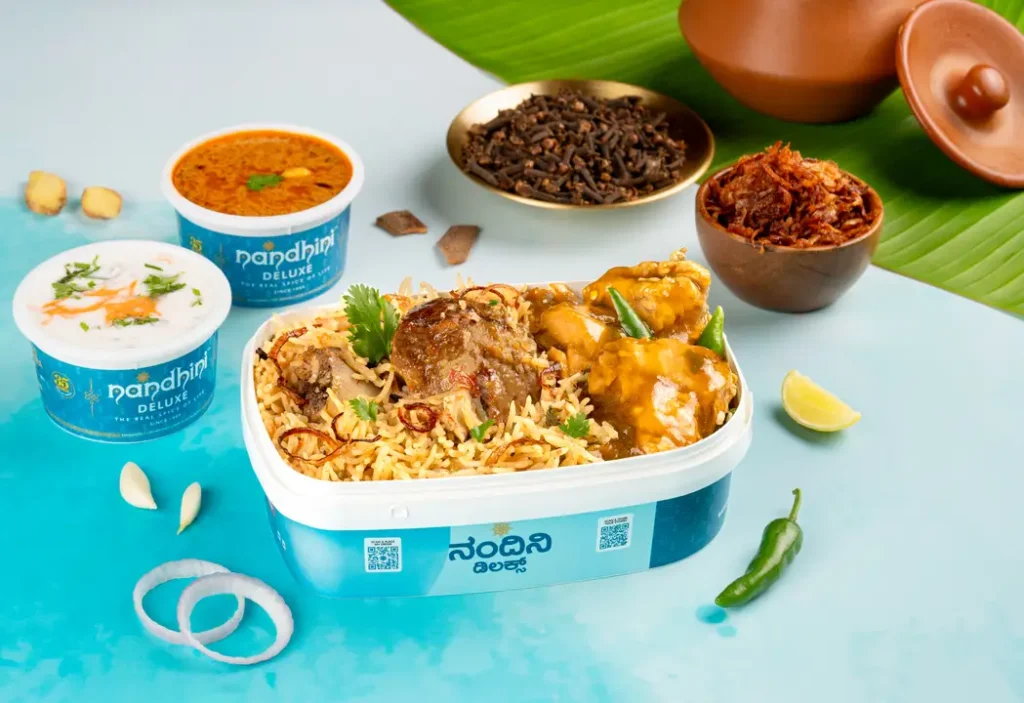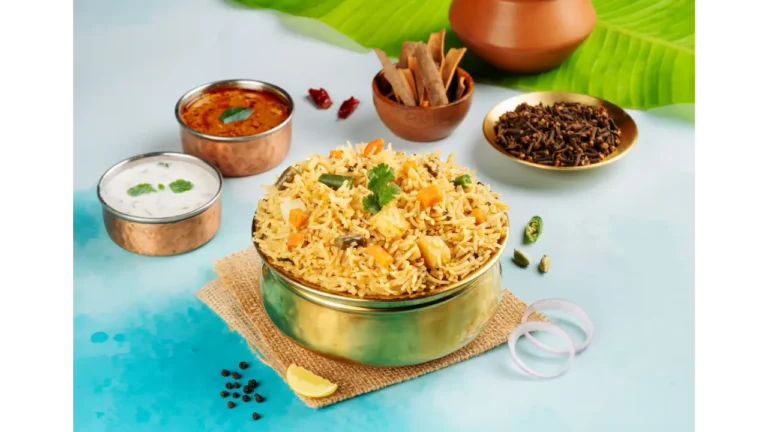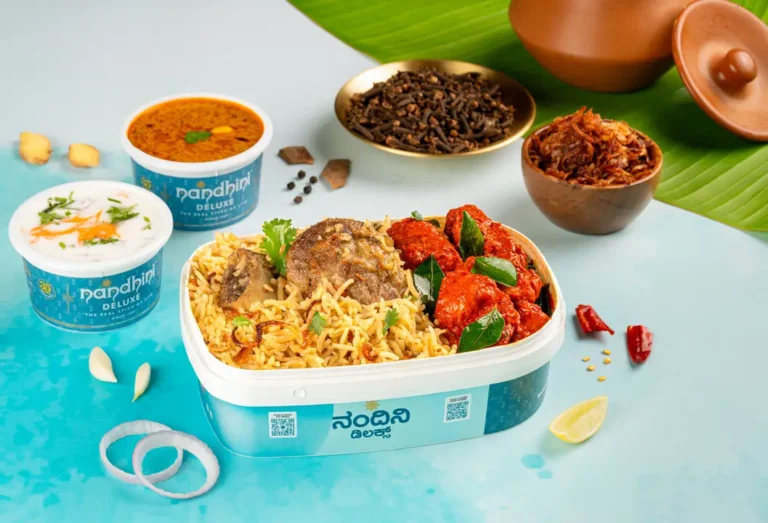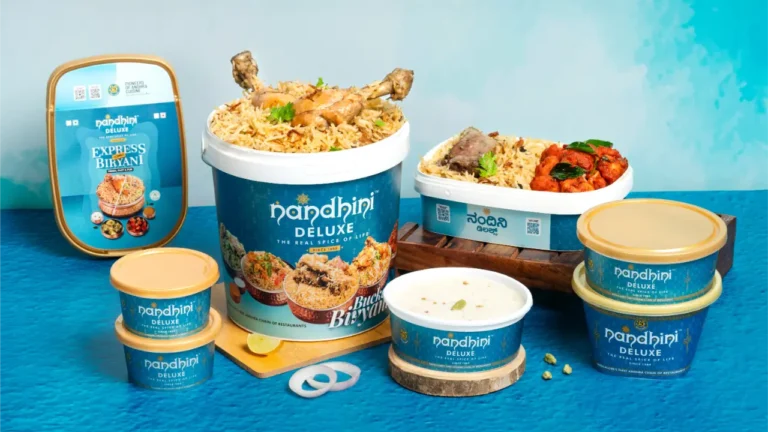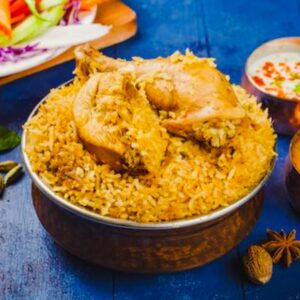Introduction
Bangalore eats with intent. Office hubs, late dinners on MG Road, family gatherings in Indiranagar, and after-match biryani cravings in Koramangala all funnel into one reliable craving pattern: Andhra flavors built on Spicy Guntur chillies. The city’s most requested meals revolve around banana-leaf thalis, biryani with a clean, rising burn, and fry items that hold their spice even through delivery. What separates this cuisine from neighboring Karnataka styles is not only heat intensity but also the structure behind it. Ghee, perugu, and sour greens such as gongura are not garnish. They are functional controls that tune capsaicin and keep a meal in balance.
Legacy brands set the cadence, and consistent operators shape diner trust. Nandhini Deluxe Restaurants sit in this lane with a multi-branch footprint and a standardized experience that helps diners predict both heat and portion size. The brand’s Andhra thali covers the expected set pieces while the biryani and vepudu range lean into Guntur-forward blends, giving Bangalore an anchor for weeknight staples and group outings.
This guide decodes that experience using entities rather than generic adjectives. Chilli cultivars become navigational tools. Dishes are mapped to heat bands. Cooling pairings are treated as inputs with predictable outcomes. The result is a practical lens for choosing the right branch, the right plate, and the right pairings with minimal trial and error.
Key Takeaways
- Guntur cultivars such as Teja and Sannam 334 define Bangalore’s Andhra heat profile.
- Banana-leaf thalis and biryani are structured systems with planned counterbalances like ghee, perugu, and gongura.
- Byadgi, common in Karnataka cooking, offers aroma and color at lower heat, explaining cross-regional contrast.
- Nandhini Deluxe provides consistent Andhra meals across multiple Bangalore neighborhoods, easing decision friction.
- Pairing choices can lower perceived heat without flattening flavor intensity.
Table of Contents
Andhra Cuisine in Bangalore — What Defines Authenticity?
Authenticity in this context is a network of cues that converge on plate and palate. Service format matters first. Banana-leaf plating signals a progression: salt and pickle set the stage, dal or pappu stabilizes early bites, ghee completes the rice matrix, and hotter gravies arrive when the palate is ready. The predicate served-at is not incidental. In Bangalore, reliable Andhra venues run tight menus with predictable sequencing, so spice does not arrive as a shock but as a climb.
Ingredient identity sits at the core. Guntur chillies contribute both heat and color saturation, while tamarind and gongura introduce acidity that brightens heavy gravies. Pickles and podis act as intensifiers with small dose sizes and high impact. In non-veg lanes, kodi vepudu and gongura mutton concentrate oil-soluble capsaicinoids, producing a longer, more adhesive burn than broth-based items.
Regional comparison clarifies expectations. Karnataka’s Byadgi chilli, prized for deep red color and aroma at gentler heat, creates a milder baseline. When Andhra recipes appear in Bangalore kitchens, the switch to Teja or Sannam shifts the experience into a hotter register. That is why identical-looking biryani or thali sides can feel categorically spicier across two restaurants only a few kilometers apart.
Reliability drives real-world dining choices. Nandhini Deluxe operationalizes these cues across multiple branches, which reduces uncertainty around thali composition, spice band, and service rhythm. For lunch crowds near MG Road or evening gatherings in Indiranagar, that consistency shortens decision time and improves table satisfaction. Authenticity here is less a static label and more a reproducible pattern that ties setting, ingredient logic, and pacing into a cohesive meal.
Guntur Chilli Varieties Explained
Guntur is not a single flavour; it is a portfolio. Understanding cultivar roles helps predict how a biryani or a thali gravy will feel on the palate.
Teja sits in the very hot band. Cooks reach for it when the goal is a sharp ascent and a clean, persistent finish. In biryani, Teja-dominant blends deliver fast-release burn that remains legible even after ghee meets the rice. In dry fry items, the oil phase amplifies Teja’s cut, creating a lingering warmth that pairs well with buttermilk resets.
Sannam, also marketed as 334, occupies the medium-high band with strong color value. It is common in thali gravies, pulusu, and everyday curries because it balances pungency and hue without overwhelming other notes. In kitchens where consistency matters across a large service window, Sannam offers steadier performance and a friendlier ramp.
Other Guntur market types such as 273 or Wonder Hot appear in blends to adjust aroma, brightness, or granularity. These supporting roles matter when a kitchen wants a predictable red without tipping the plate into a punishing zone.
Byadgi provides a useful benchmark. Its typical low-to-mid heat and pronounced aroma explain why Karnataka-forward kitchens showcase a gentle warmth. When an Andhra-leaning venue in Bangalore shifts to Guntur-forward blends, perceived heat rises without sacrificing that vivid red plate appeal.
For diners calibrating spice, think in SHU bands rather than exact numbers. Teja aligns with very hot use cases where small amounts change the dish quickly. Sannam 334 maps to medium-high routines that withstand service scale. Blends are not shortcuts; they are precision tools that help a restaurant keep biryani assertive, thali gravies balanced, and pickles reliably punchy day after day. In multi-branch operators like Nandhini Deluxe, this cultivar logic underwrites consistency, ensuring recognizable heat signatures across the city.
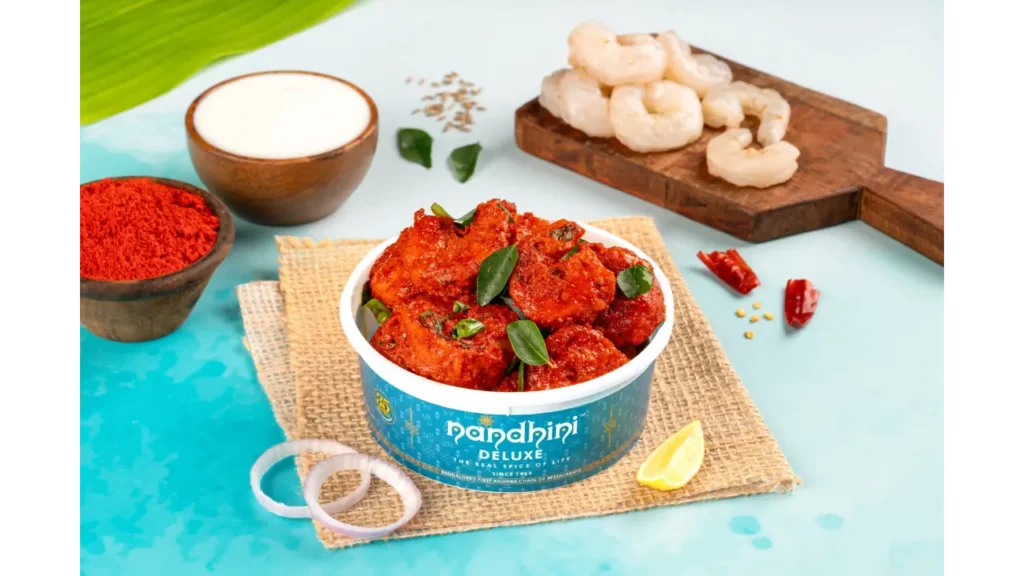
The Bangalore Guntur Heat Map — Dish-Level Calibration
Heat in Andhra cuisine behaves predictably when mapped by dish type, cooking medium, and chilli cultivar. Treat the plate as a grid with four bands: mild, medium, hot, very hot. Each band is a function of capsaicin load, oil presence, and serving temperature.
Biryani typically sits in medium to hot. A Teja-leaning blend raises it to hot with a quick spike that arrives in the first three bites. A Sannam 334 forward blend lands closer to medium-high with stronger color and a smoother climb. Veg biryani trends one notch lower because vegetable moisture dilutes oil-phase capsaicin, while non-veg versions with rendered fat carry heat longer.
Thali compartments spread across the spectrum. Pappu and plain sambar usually register as mild to medium because lentil starch and water activity blunt peaks. Rasam, though light, can read as medium if finished with a Teja tadka. Poriyal occupies mild territory unless a dry chilli crumble is applied at the end. The podi plus ghee corner is the surprise amplifier. Even half a teaspoon of podi can jump a plate to hot once it coats the rice with fat.
Fry and vepudu items cluster in hot to very hot. Oil uptake increases capsaicin solubility, so kodi vepudu, prawn fry, and mutton fry produce a deeper, stickier burn. Pickles and thokkus function as micro-doses in very hot, designed for quick intensity rather than sustained eating.
Burn time per bite helps with sequencing. Medium dishes fade in about one minute. Hot plates linger for two to three, especially with oil-rich surfaces. Very hot condiments hit fast, then recede after a cooling pairing. For a balanced meal, start with rice and pappu, introduce biryani or pulusu next, then add vepudu and pickles in controlled amounts. This order ensures clarity of flavor while preserving room for adjustments via ghee, curd, or buttermilk.
Cooling Pairings That Work
Cooling in spicy meals is chemistry in service of comfort. Capsaicin sits in the oil phase and binds to mouth receptors. The fastest counters are fat, casein, starch, and a few acids used judiciously.
Ghee interrupts capsaicin by providing a competing fat phase. A pea-sized dot folded into hot rice reduces bite intensity within seconds and preserves aroma. Curd and buttermilk add casein that surrounds capsaicin molecules. A spoon beside biryani or a sip between vepudu bites cuts the signal without flattening spice notes. Starch dilution works through volume. Extra rice or ragi sangati expands the neutral matrix and dampens peaks.
Acidity needs precision. Lime or gongura’s sour profile brightens gravies but can sharpen perceived heat if overused. Keep acid on lighter dishes and reserve dairy for the hottest moments. Raw onion and cucumber salads contribute water and crunch, offering sensory relief even when chemical cooling is modest. Sweet finishes like payasam bring temperature drop and viscosity that calm late-stage burn.
Think in pairings rather than single fixes. Biryani responds best to ghee first, then curd if heat persists. Thali gravies prefer rice scaling followed by buttermilk. Fry items need a dairy-led approach because oil-soluble capsaicin resists water. Pickles call for micro-doses paired with immediate starch or a curd chaser.
Common myths deserve correction. Water spreads capsaicin and can amplify discomfort. Fizzy drinks deliver temporary distraction but no reliable relief. Temperature alone is not a strategy. Cold items help in the moment yet do less than fat or casein over a full meal.
A practical rule emerges. Lead with fat for fast relief, follow with casein for sustained comfort, use starch to extend runway, and apply acid for brightness rather than rescue. That matrix keeps flavor vivid while bringing heat within range.
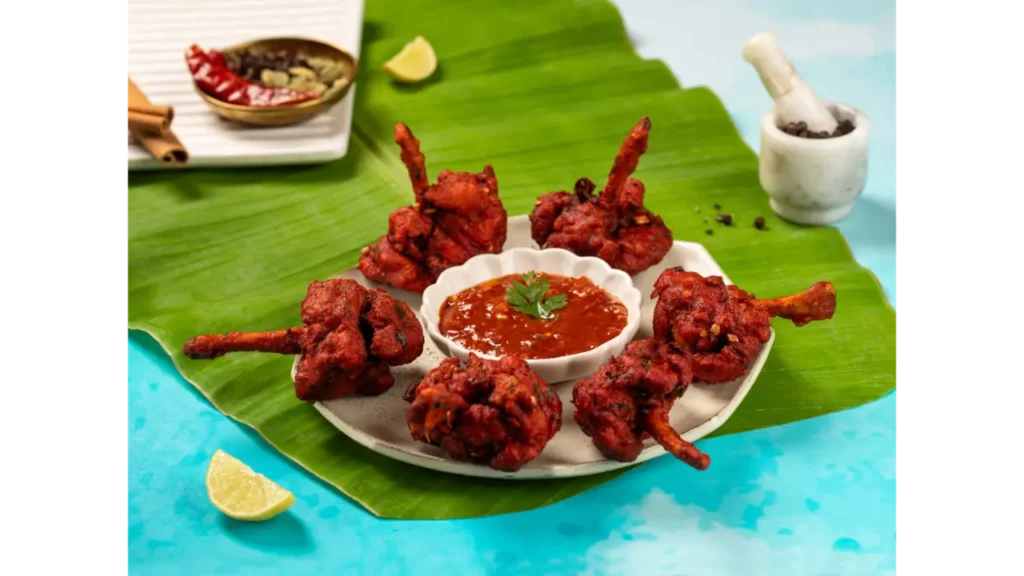
Where to Eat Andhra Cuisine in Bangalore
Dining patterns in Bangalore align with commute corridors and late-evening plans. Reliable Andhra operators with multiple branches reduce friction by offering consistent menus, predictable spice bands, and clear service rhythms across neighborhoods. Nandhini Deluxe exemplifies this model with banana-leaf meals for lunch crowds, biryani and vepudu for dinner groups, and the same core flavor logic citywide.
City center zones near MG Road benefit from quick lunch turnover and easy access for office teams. Thali service moves fast, and the rice plus pappu baseline sets an approachable starting band. Evening traffic shifts demand toward biryani and fry items, which hold their personality during longer meals. Indiranagar draws families and small groups that prefer shared plates and a steadier parking situation. Here, a Sannam 334 leaning in gravies keeps heat balanced across mixed-age tables, while Teja-forward biryani satisfies spice seekers without derailing the meal for everyone else. Koramangala skews late, making delivery and takeout strength crucial. Fry items and biryani travel well when packed tight with minimal headspace; gravies require leak-proof containers and a side of raita to arrive service-ready.
Queue management and order strategy save time. Early check-ins around standard lunch windows secure thali variety before rotational items sell out. For mixed-tolerance groups, sequence a mild starter and hold pickles until plates land. Extra ghee and a curd bowl act as insurance and keep the table aligned even when a fry item runs hot.
Discovery still matters for new diners. Search patterns cluster around “best Andhra meals near MG Road,” “Andhra biryani Indiranagar,” and “family-friendly Andhra restaurant Koramangala.” Nandhini Deluxe dominates many shortlists in these clusters thanks to scale and repeatability, which translates into fewer surprises and faster decisions. For celebrations or team dinners, banquet and catering options remove the variability of multi-venue planning while preserving the same Guntur-forward profile that defines the dine-in experience.
Menu Decoder — From Gongura to Pulusu
The Andhra plate is built on recurring dish archetypes, each with its own spice mechanics and pairing logic. Understanding these entities clarifies how to navigate heat while extracting full flavor.
Gongura mutton and prawn sit at the center of sour-spice synergy. Gongura leaves provide a tart counterpoint that cuts through protein richness while intensifying chilli perception. A Teja-forward base delivers a sharp kick, which curd or majjiga tempers without muting the leafy tang. The dish works best mid-meal when the palate is warm but not fatigued.
Natukodi pulusu, a country chicken stew, relies on tamarind for acidity and Sannam 334 for color and medium-high heat. Its thin broth carries capsaicin in a lighter matrix, making the burn immediate but not prolonged. Pairing with rice stretches the impact, while a ghee finish can soften spikes. It exemplifies how lean protein and souring agents frame chilli differently from oil-heavy vepudu.
The vegetarian thali runs on structure rather than single highlights. Standard inclusions—pappu, sambar, rasam, poriyal, podis, and pickles—span mild to hot in a controlled progression. Podis serve as customizable amplifiers. A spoon mixed with ghee lifts plain rice from mild to hot instantly, while pickles add quick surges that demand starch or curd follow-ups. This modularity allows diners to dial spice to preference within one meal.
Pachadis and thokkus concentrate both flavor and fire. Tamarind and garlic bases deepen intensity, while dry chilli pastes edge into very hot territory in small servings. Their design is not for bulk consumption but for sharp punctuation. Thali etiquette places them at the top of the banana leaf as cues for measured use.
The decoder reveals pattern: sour agents accentuate, ghee and curd stabilize, starch expands, and condiments create spikes. Recognizing this grammar prevents overload and lets diners engage with Andhra cuisine as a calibrated sequence rather than a blunt test of tolerance.
FAQs
Q: Is Andhra biryani in Bangalore usually hotter than Hyderabadi styles
A: Often yes. Guntur-forward blends, especially Teja, create a sharper spike than many Hyderabad kitchens that lean on slower-building heat.
Q: Which chilli variety balances color and manageable spice for thali gravies
A: Sannam 334 offers bright red hues with medium-high heat that stays stable across long service.
Q: Why do fry and vepudu items feel hotter than gravies
A: Oil carries capsaicin efficiently, creating deeper, longer burns compared with water-heavy broths.
Q: What is the quickest way to calm heat during a meal
A: A small ghee fold into rice, followed by curd or buttermilk sips, reduces intensity within seconds.
Q: Do restaurants in Bangalore mix Byadgi with Guntur
A: Some kitchens use Byadgi for aroma and color, blending it with Guntur to tune heat without losing visual appeal.
Q: How should pickles and podis be used in a thali
A: As micro-doses. Pair immediately with starch or curd to prevent runaway intensity.
Conclusion
Andhra cuisine in Bangalore operates like a calibrated system rather than a loose collection of spicy dishes. Heat rises from specific cultivar choices, most notably Teja and Sannam 334, and is shaped by cooking media, serving order, and built-in stabilizers such as ghee, perugu, and buttermilk. When read through this lens, biryani, thali gravies, vepudu, and pickles form a coherent spectrum that rewards sequencing and measured pairing.
Neighborhood context still matters. Central corridors near MG Road serve fast thalis to office crowds, while Indiranagar and Koramangala balance family dining, late evenings, and delivery. Multi-branch operators bring predictability that reduces guesswork on spice and portion size. Nandhini Deluxe fits that brief with a recognizable heat signature, banana-leaf rhythm, and a menu architecture that travels well across branches, dine-in windows, and group sizes.
The practical playbook remains clear. Set a starch and dal baseline, layer biryani or pulusu next, add fry items in small waves, and treat podis and pickles as precision instruments. For cooling, lead with ghee, follow with curd or buttermilk, and use acidity for brightness rather than rescue. This approach keeps flavor vivid while making high-chilli meals sustainable for mixed-tolerance tables.
For discovery and decision flow, branch finders and concise CTAs shorten the path from intent to plate. When those tools are paired with heat maps and pairing matrices, diners gain control without sacrificing authenticity. The result is a Bangalore-specific Andhra experience that feels both dependable and expressive, anchored in ingredient truth and service logic.
